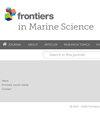Strain-specific responses of Pyropia haitanensis to light intensity in growth, carbon content, and organic carbon release
IF 3
2区 生物学
Q1 MARINE & FRESHWATER BIOLOGY
引用次数: 0
Abstract
Light strongly influences the carbon (C) metabolism of seaweed through both algal carbon content and organic carbon release, thereby driving the carbon cycling of coastal oceans. However, the response of seaweed organic carbon release to varying light intensities remains an underexplored area of research. This study aimed to fill this gap by analyzing the effects of four different light intensities (5, 50, 200, and 500 μmol m海檀焦豆生长、碳含量和有机碳释放对光照强度的响应
光通过藻碳含量和有机碳释放强烈影响海藻的碳(C)代谢,从而推动沿海海洋的碳循环。然而,海藻有机碳释放对不同光强的响应仍然是一个未开发的研究领域。本研究通过分析5、50、200和500 μmol m-2 s-1 4种光照强度对海檀焦皮藻(Pyropia haitanensis) 2株菌株W28-42和WO15-4生长、碳含量和有机碳释放的影响,填补了这一空白。结果表明,随着光强的增加,两种菌株的生长速率均呈现先上升后下降的趋势,在200 μmol m-2 s-1时生长速率最高;同时,组织C含量随光照强度的增加而增加,氮、磷含量随光照强度的增加而降低。这导致了C:N和C:P比值的增加,表明高光强可能增强了C的固定,抑制了N和P的吸收。特别令人感兴趣的是两种菌株之间有机碳释放的差异。菌株W28-42的溶解有机碳(DOC)释放率随光强的变化而显著增加,而菌株WO15-4的DOC释放率不受光强变化的影响。在较高的光强下,两种菌株的颗粒有机碳(POC)释放率均有所增加,其中W28-42比WO15-4的增加幅度更大。本研究表明,海棠释放DOC对光照强度的变化表现出明显的菌株特异性反应,这一结果可能归因于光合生理和基因组成的差异。这些见解为通过操纵光强度来提高渔业碳汇的效率提供了基础。
本文章由计算机程序翻译,如有差异,请以英文原文为准。
求助全文
约1分钟内获得全文
求助全文
来源期刊

Frontiers in Marine Science
Agricultural and Biological Sciences-Aquatic Science
CiteScore
5.10
自引率
16.20%
发文量
2443
审稿时长
14 weeks
期刊介绍:
Frontiers in Marine Science publishes rigorously peer-reviewed research that advances our understanding of all aspects of the environment, biology, ecosystem functioning and human interactions with the oceans. Field Chief Editor Carlos M. Duarte at King Abdullah University of Science and Technology Thuwal is supported by an outstanding Editorial Board of international researchers. This multidisciplinary open-access journal is at the forefront of disseminating and communicating scientific knowledge and impactful discoveries to researchers, academics, policy makers and the public worldwide.
With the human population predicted to reach 9 billion people by 2050, it is clear that traditional land resources will not suffice to meet the demand for food or energy, required to support high-quality livelihoods. As a result, the oceans are emerging as a source of untapped assets, with new innovative industries, such as aquaculture, marine biotechnology, marine energy and deep-sea mining growing rapidly under a new era characterized by rapid growth of a blue, ocean-based economy. The sustainability of the blue economy is closely dependent on our knowledge about how to mitigate the impacts of the multiple pressures on the ocean ecosystem associated with the increased scale and diversification of industry operations in the ocean and global human pressures on the environment. Therefore, Frontiers in Marine Science particularly welcomes the communication of research outcomes addressing ocean-based solutions for the emerging challenges, including improved forecasting and observational capacities, understanding biodiversity and ecosystem problems, locally and globally, effective management strategies to maintain ocean health, and an improved capacity to sustainably derive resources from the oceans.
 求助内容:
求助内容: 应助结果提醒方式:
应助结果提醒方式:


